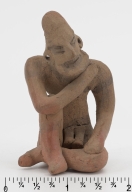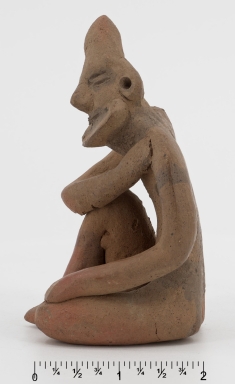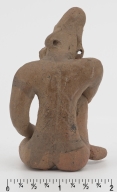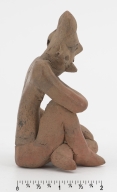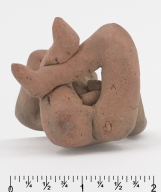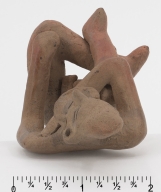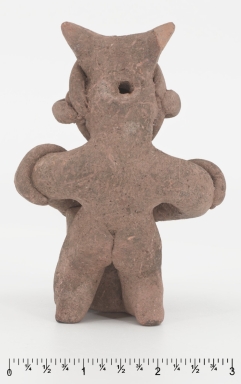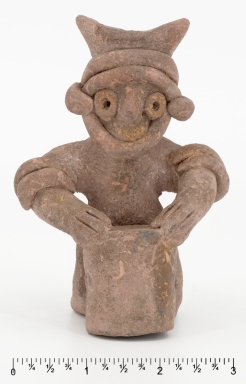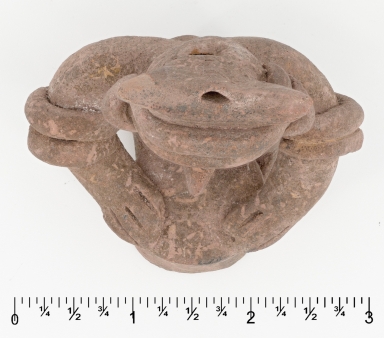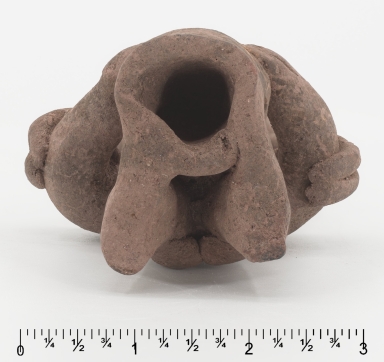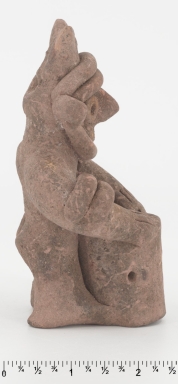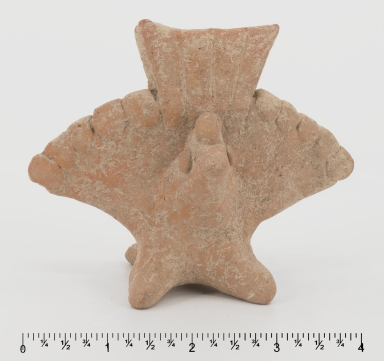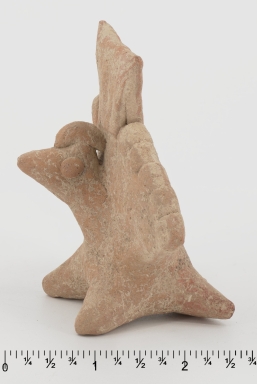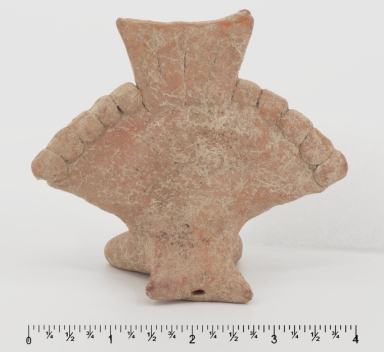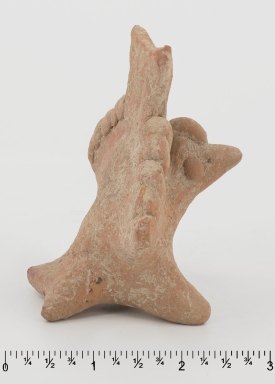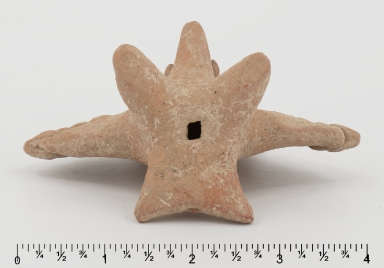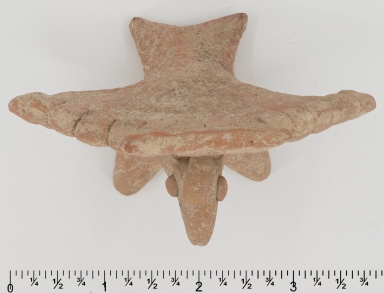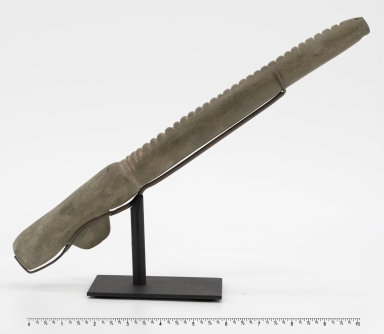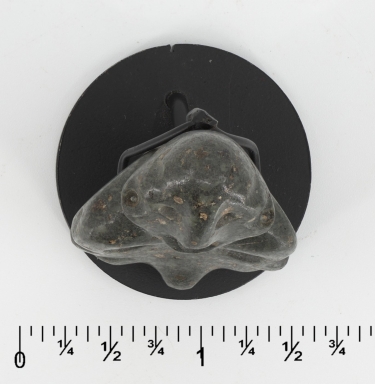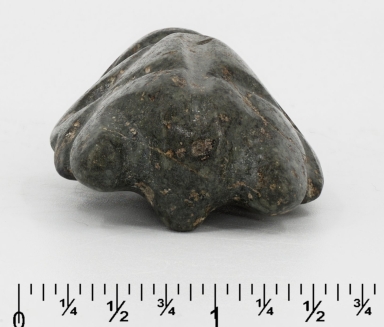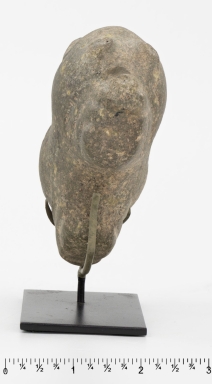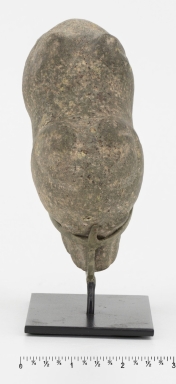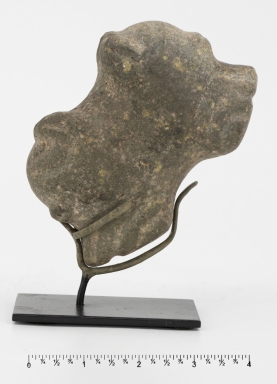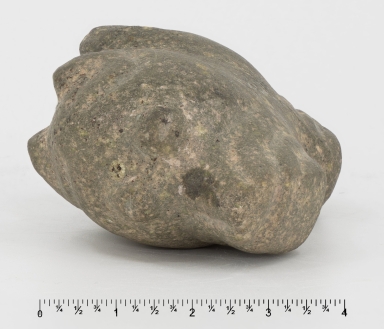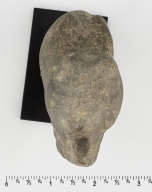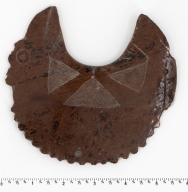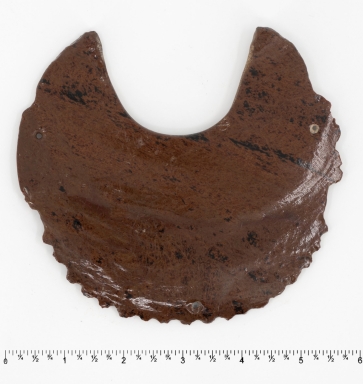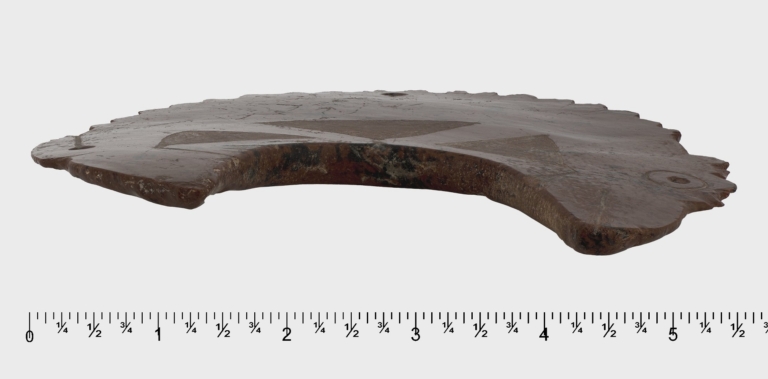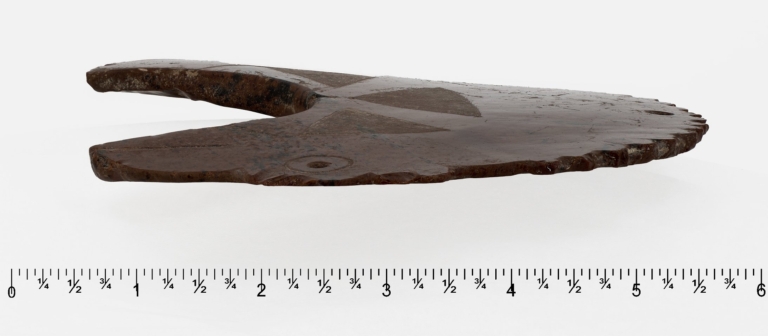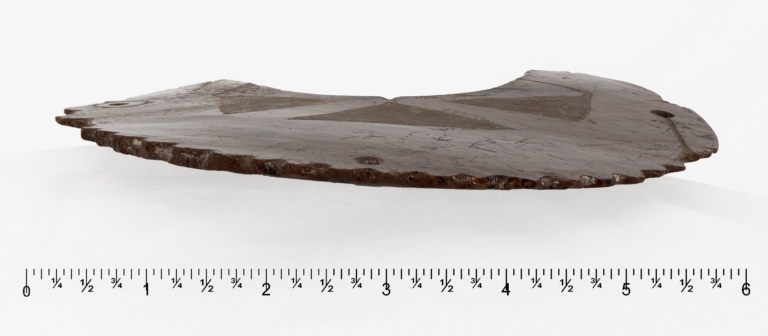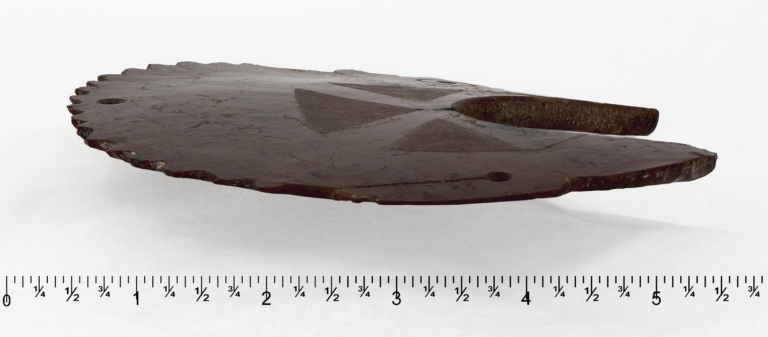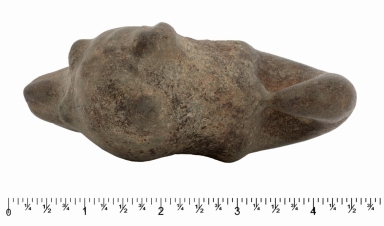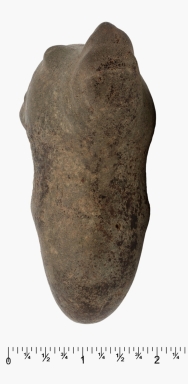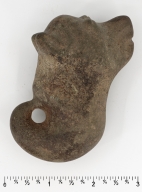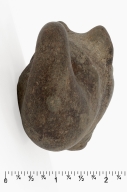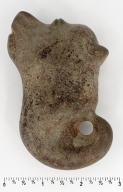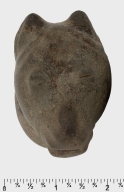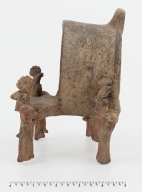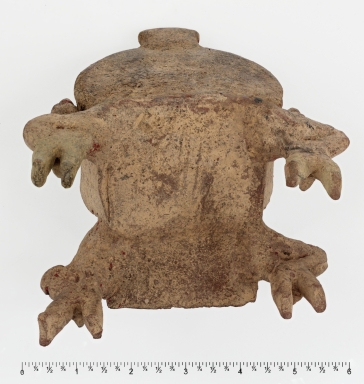Who What Where WhenREMOVEWHAT
|
Title
Seated couple : male with hand on shoulder.
Description
A male sits with his right knee drawn to his body and he rests his right elbow on it. He touches his left shoulder with his right hand. He has traces of black pigment on his eyes, mouth, upper arms, clothing, and right leg.
Subject
[Ceramic sculpture--Mexico--Colima (State), Art--Mexico--Colima (State), Indigenous peoples--Antiquities]
Date
between 300 B.C. and 300 A.D.
Title
Seated couple : male with hand on shoulder.
Description
A male sits with his right knee drawn to his body and he rests his right elbow on it. He touches his left shoulder with his right hand. He has traces of black pigment on his eyes, mouth, upper arms, clothing, and right leg.
Subject
[Ceramic sculpture--Mexico--Colima (State), Art--Mexico--Colima (State), Indigenous peoples--Antiquities]
Date
between 300 B.C. and 300 A.D.
Title
Seated couple : male with hand on shoulder.
Description
A male sits with his right knee drawn to his body and he rests his right elbow on it. He touches his left shoulder with his right hand. He has traces of black pigment on his eyes, mouth, upper arms, clothing, and right leg.
Subject
[Ceramic sculpture--Mexico--Colima (State), Art--Mexico--Colima (State), Indigenous peoples--Antiquities]
Date
between 300 B.C. and 300 A.D.
Title
Seated couple : male with hand on shoulder.
Description
A male sits with his right knee drawn to his body and he rests his right elbow on it. He touches his left shoulder with his right hand. He has traces of black pigment on his eyes, mouth, upper arms, clothing, and right leg.
Subject
[Ceramic sculpture--Mexico--Colima (State), Art--Mexico--Colima (State), Indigenous peoples--Antiquities]
Date
between 300 B.C. and 300 A.D.
Title
Seated couple : male with hand on shoulder.
Description
A male sits with his right knee drawn to his body and he rests his right elbow on it. He touches his left shoulder with his right hand. He has traces of black pigment on his eyes, mouth, upper arms, clothing, and right leg.
Subject
[Ceramic sculpture--Mexico--Colima (State), Art--Mexico--Colima (State), Indigenous peoples--Antiquities]
Date
between 300 B.C. and 300 A.D.
Title
Seated couple : male with hand on shoulder.
Description
A male sits with his right knee drawn to his body and he rests his right elbow on it. He touches his left shoulder with his right hand. He has traces of black pigment on his eyes, mouth, upper arms, clothing, and right leg.
Subject
[Ceramic sculpture--Mexico--Colima (State), Art--Mexico--Colima (State), Indigenous peoples--Antiquities]
Date
between 300 B.C. and 300 A.D.
Title
Standing Drummer with Double Horned Headdress
Description
This drummer is a musical whistle. Music plays an important role in all societies. Drummers are used to set the rhythm of the music. This drummer wears a double-horned headdress and a pair of armbands.
Subject
[Ceramic sculpture--Mexico--Colima (State), Art--Mexico--Colima (State), Indigenous peoples--Antiquities]
Date
between 250 B.C. and 250 A.D.
Title
Standing Drummer with Double Horned Headdress
Description
This drummer is a musical whistle. Music plays an important role in all societies. Drummers are used to set the rhythm of the music. This drummer wears a double-horned headdress and a pair of armbands.
Subject
[Ceramic sculpture--Mexico--Colima (State), Art--Mexico--Colima (State), Indigenous peoples--Antiquities]
Date
between 250 B.C. and 250 A.D.
Title
Standing Drummer with Double Horned Headdress
Description
This drummer is a musical whistle. Music plays an important role in all societies. Drummers are used to set the rhythm of the music. This drummer wears a double-horned headdress and a pair of armbands.
Subject
[Ceramic sculpture--Mexico--Colima (State), Art--Mexico--Colima (State), Indigenous peoples--Antiquities]
Date
between 250 B.C. and 250 A.D.
Title
Standing Drummer with Double Horned Headdress
Description
This drummer is a musical whistle. Music plays an important role in all societies. Drummers are used to set the rhythm of the music. This drummer wears a double-horned headdress and a pair of armbands.
Subject
[Ceramic sculpture--Mexico--Colima (State), Art--Mexico--Colima (State), Indigenous peoples--Antiquities]
Date
between 250 B.C. and 250 A.D.
Title
Standing Drummer with Double Horned Headdress
Description
This drummer is a musical whistle. Music plays an important role in all societies. Drummers are used to set the rhythm of the music. This drummer wears a double-horned headdress and a pair of armbands.
Subject
[Ceramic sculpture--Mexico--Colima (State), Art--Mexico--Colima (State), Indigenous peoples--Antiquities]
Date
between 250 B.C. and 250 A.D.
Title
Standing Drummer with Double Horned Headdress
Description
This drummer is a musical whistle. Music plays an important role in all societies. Drummers are used to set the rhythm of the music. This drummer wears a double-horned headdress and a pair of armbands.
Subject
[Ceramic sculpture--Mexico--Colima (State), Art--Mexico--Colima (State), Indigenous peoples--Antiquities]
Date
between 250 B.C. and 250 A.D.
Title
Zoomorphic Whistle : Bird : Turkey
Description
A Colima ceramicist hand formed and appliqued this zoomorphic whistle. The avian form has a fleshy comb or crest and it displays a splayed tail, but not sufficient details to identify the species.
Subject
[Ceramic sculpture--Mexico--Colima (State), Whistles--Mexico--Colima (State), Art--Mexico--Colima (State), Indigenous peoples--Antiquities]
Date
between 250 B.C. and 250 A.D.
Title
Zoomorphic Whistle : Bird : Turkey
Description
A Colima ceramicist hand formed and appliqued this zoomorphic whistle. The avian form has a fleshy comb or crest and it displays a splayed tail, but not sufficient details to identify the species.
Subject
[Ceramic sculpture--Mexico--Colima (State), Whistles--Mexico--Colima (State), Art--Mexico--Colima (State), Indigenous peoples--Antiquities]
Date
between 250 B.C. and 250 A.D.
Title
Zoomorphic Whistle : Bird : Turkey
Description
A Colima ceramicist hand formed and appliqued this zoomorphic whistle. The avian form has a fleshy comb or crest and it displays a splayed tail, but not sufficient details to identify the species.
Subject
[Ceramic sculpture--Mexico--Colima (State), Whistles--Mexico--Colima (State), Art--Mexico--Colima (State), Indigenous peoples--Antiquities]
Date
between 250 B.C. and 250 A.D.
Title
Zoomorphic Whistle : Bird : Turkey
Description
A Colima ceramicist hand formed and appliqued this zoomorphic whistle. The avian form has a fleshy comb or crest and it displays a splayed tail, but not sufficient details to identify the species.
Subject
[Ceramic sculpture--Mexico--Colima (State), Whistles--Mexico--Colima (State), Art--Mexico--Colima (State), Indigenous peoples--Antiquities]
Date
between 250 B.C. and 250 A.D.
Title
Zoomorphic Whistle : Bird : Turkey
Description
A Colima ceramicist hand formed and appliqued this zoomorphic whistle. The avian form has a fleshy comb or crest and it displays a splayed tail, but not sufficient details to identify the species.
Subject
[Ceramic sculpture--Mexico--Colima (State), Whistles--Mexico--Colima (State), Art--Mexico--Colima (State), Indigenous peoples--Antiquities]
Date
between 250 B.C. and 250 A.D.
Title
Zoomorphic Whistle : Bird : Turkey
Description
A Colima ceramicist hand formed and appliqued this zoomorphic whistle. The avian form has a fleshy comb or crest and it displays a splayed tail, but not sufficient details to identify the species.
Subject
[Ceramic sculpture--Mexico--Colima (State), Whistles--Mexico--Colima (State), Art--Mexico--Colima (State), Indigenous peoples--Antiquities]
Date
between 250 B.C. and 250 A.D.
Title
Anthropomorphic musical rasp.
Description
Ceramic Nayarit musicians demonstrate how a rasp was held, played, and looked. A grooved rasp was played with a bore, a shell or wooden object that was dragged over the grooves to produce an unusual sound.
Subject
[Files and rasps, Percussion instruments--Mexico--Colima (State), Art--Mexico--Colima (State), Indigenous peoples--Antiquities]
Date
between 250 B.C. and 250 A.D.
Title
Anthropomorphic musical rasp.
Description
Ceramic Nayarit musicians demonstrate how a rasp was held, played, and looked. A grooved rasp was played with a bore, a shell or wooden object that was dragged over the grooves to produce an unusual sound.
Subject
[Files and rasps, Percussion instruments--Mexico--Colima (State), Art--Mexico--Colima (State), Indigenous peoples--Antiquities]
Date
between 250 B.C. and 250 A.D.
Title
Anthropomorphic musical rasp.
Description
Ceramic Nayarit musicians demonstrate how a rasp was held, played, and looked. A grooved rasp was played with a bore, a shell or wooden object that was dragged over the grooves to produce an unusual sound.
Subject
[Files and rasps, Percussion instruments--Mexico--Colima (State), Art--Mexico--Colima (State), Indigenous peoples--Antiquities]
Date
between 250 B.C. and 250 A.D.
Title
Anthropomorphic musical rasp.
Description
Ceramic Nayarit musicians demonstrate how a rasp was held, played, and looked. A grooved rasp was played with a bore, a shell or wooden object that was dragged over the grooves to produce an unusual sound.
Subject
[Files and rasps, Percussion instruments--Mexico--Colima (State), Art--Mexico--Colima (State), Indigenous peoples--Antiquities]
Date
between 250 B.C. and 250 A.D.
Title
Colima anthropomorphic, zoomorphic figure.
Description
The eyes, ears, mouth, and spine were inlaid in this figurative deep blue-green stone. The stone's image is obviously male, but less apparent are the secondary front and rear faces. Lay the stone stomach down, it transforms into a resting frog, the symbol of fertility. The stone transforms from a man to a frog and maybe a dog.
Subject
[Sculpture--Mexico--Colima (State), Stone carving--Mexico--Colima (State), Art--Mexico--Colima (State), Indigenous peoples--Antiquities]
Date
between 300 B.C. and 300 A.D.
Title
Colima anthropomorphic, zoomorphic figure.
Description
The eyes, ears, mouth, and spine were inlaid in this figurative deep blue-green stone. The stone's image is obviously male, but less apparent are the secondary front and rear faces. Lay the stone stomach down, it transforms into a resting frog, the symbol of fertility. The stone transforms from a man to a frog and maybe a dog.
Subject
[Sculpture--Mexico--Colima (State), Stone carving--Mexico--Colima (State), Art--Mexico--Colima (State), Indigenous peoples--Antiquities]
Date
between 300 B.C. and 300 A.D.
Title
Colima anthropomorphic, zoomorphic figure.
Description
The eyes, ears, mouth, and spine were inlaid in this figurative deep blue-green stone. The stone's image is obviously male, but less apparent are the secondary front and rear faces. Lay the stone stomach down, it transforms into a resting frog, the symbol of fertility. The stone transforms from a man to a frog and maybe a dog.
Subject
[Sculpture--Mexico--Colima (State), Stone carving--Mexico--Colima (State), Art--Mexico--Colima (State), Indigenous peoples--Antiquities]
Date
between 300 B.C. and 300 A.D.
Title
Colima anthropomorphic, zoomorphic figure.
Description
The eyes, ears, mouth, and spine were inlaid in this figurative deep blue-green stone. The stone's image is obviously male, but less apparent are the secondary front and rear faces. Lay the stone stomach down, it transforms into a resting frog, the symbol of fertility. The stone transforms from a man to a frog and maybe a dog.
Subject
[Sculpture--Mexico--Colima (State), Stone carving--Mexico--Colima (State), Art--Mexico--Colima (State), Indigenous peoples--Antiquities]
Date
between 300 B.C. and 300 A.D.
Title
Colima anthropomorphic, zoomorphic figure.
Description
The eyes, ears, mouth, and spine were inlaid in this figurative deep blue-green stone. The stone's image is obviously male, but less apparent are the secondary front and rear faces. Lay the stone stomach down, it transforms into a resting frog, the symbol of fertility. The stone transforms from a man to a frog and maybe a dog.
Subject
[Sculpture--Mexico--Colima (State), Stone carving--Mexico--Colima (State), Art--Mexico--Colima (State), Indigenous peoples--Antiquities]
Date
between 300 B.C. and 300 A.D.
Title
Colima anthropomorphic, zoomorphic figure.
Description
The eyes, ears, mouth, and spine were inlaid in this figurative deep blue-green stone. The stone's image is obviously male, but less apparent are the secondary front and rear faces. Lay the stone stomach down, it transforms into a resting frog, the symbol of fertility. The stone transforms from a man to a frog and maybe a dog.
Subject
[Sculpture--Mexico--Colima (State), Stone carving--Mexico--Colima (State), Art--Mexico--Colima (State), Indigenous peoples--Antiquities]
Date
between 300 B.C. and 300 A.D.
Title
Macehead : transforming images : 2.
Description
A macehead is a symbol of power, authority, and an object of destruction. The dog heads could represent food, companionship, warmth, or a guide or visitor to the underworld. Turn the macehead over and there are two horned frogs, a good source of a hallucinogenic drug. The poison allowed a shaman access to other worlds. The frog is associated with renewal, change, or transformation and fertility.
Subject
[Sculpture--Mexico--Colima (State), Stone carving--Mexico--Colima (State), Art--Mexico--Colima (State), Indigenous peoples--Antiquities]
Date
between 250 B.C. and 200 A.D.
Title
Macehead : transforming images : 2.
Description
A macehead is a symbol of power, authority, and an object of destruction. The dog heads could represent food, companionship, warmth, or a guide or visitor to the underworld. Turn the macehead over and there are two horned frogs, a good source of a hallucinogenic drug. The poison allowed a shaman access to other worlds. The frog is associated with renewal, change, or transformation and fertility.
Subject
[Sculpture--Mexico--Colima (State), Stone carving--Mexico--Colima (State), Art--Mexico--Colima (State), Indigenous peoples--Antiquities]
Date
between 250 B.C. and 200 A.D.
Title
Macehead : transforming images : 2.
Description
A macehead is a symbol of power, authority, and an object of destruction. The dog heads could represent food, companionship, warmth, or a guide or visitor to the underworld. Turn the macehead over and there are two horned frogs, a good source of a hallucinogenic drug. The poison allowed a shaman access to other worlds. The frog is associated with renewal, change, or transformation and fertility.
Subject
[Sculpture--Mexico--Colima (State), Stone carving--Mexico--Colima (State), Art--Mexico--Colima (State), Indigenous peoples--Antiquities]
Date
between 250 B.C. and 200 A.D.
Title
Macehead : transforming images : 2.
Description
A macehead is a symbol of power, authority, and an object of destruction. The dog heads could represent food, companionship, warmth, or a guide or visitor to the underworld. Turn the macehead over and there are two horned frogs, a good source of a hallucinogenic drug. The poison allowed a shaman access to other worlds. The frog is associated with renewal, change, or transformation and fertility.
Subject
[Sculpture--Mexico--Colima (State), Stone carving--Mexico--Colima (State), Art--Mexico--Colima (State), Indigenous peoples--Antiquities]
Date
between 250 B.C. and 200 A.D.
Title
Macehead : transforming images : 2.
Description
A macehead is a symbol of power, authority, and an object of destruction. The dog heads could represent food, companionship, warmth, or a guide or visitor to the underworld. Turn the macehead over and there are two horned frogs, a good source of a hallucinogenic drug. The poison allowed a shaman access to other worlds. The frog is associated with renewal, change, or transformation and fertility.
Subject
[Sculpture--Mexico--Colima (State), Stone carving--Mexico--Colima (State), Art--Mexico--Colima (State), Indigenous peoples--Antiquities]
Date
between 250 B.C. and 200 A.D.
Title
Macehead : transforming images : 2.
Description
A macehead is a symbol of power, authority, and an object of destruction. The dog heads could represent food, companionship, warmth, or a guide or visitor to the underworld. Turn the macehead over and there are two horned frogs, a good source of a hallucinogenic drug. The poison allowed a shaman access to other worlds. The frog is associated with renewal, change, or transformation and fertility.
Subject
[Sculpture--Mexico--Colima (State), Stone carving--Mexico--Colima (State), Art--Mexico--Colima (State), Indigenous peoples--Antiquities]
Date
between 250 B.C. and 200 A.D.
Title
Mahogany obsidian pectoral.
Description
This crescent-shaped pectoral has two pointed ends, which can be interpreted as a two-headed bird, a caiman, or an iguana. The pectoral represents duality and transformation.
Subject
[Stone carving--Mexico--Colima (State), Art--Mexico--Colima (State), Indigenous peoples--Antiquities]
Date
between 250 B.C. and 250 A.D.
Title
Mahogany obsidian pectoral.
Description
This crescent-shaped pectoral has two pointed ends, which can be interpreted as a two-headed bird, a caiman, or an iguana. The pectoral represents duality and transformation.
Subject
[Stone carving--Mexico--Colima (State), Art--Mexico--Colima (State), Indigenous peoples--Antiquities]
Date
between 250 B.C. and 250 A.D.
Title
Mahogany obsidian pectoral.
Description
This crescent-shaped pectoral has two pointed ends, which can be interpreted as a two-headed bird, a caiman, or an iguana. The pectoral represents duality and transformation.
Subject
[Stone carving--Mexico--Colima (State), Art--Mexico--Colima (State), Indigenous peoples--Antiquities]
Date
between 250 B.C. and 250 A.D.
Title
Mahogany obsidian pectoral.
Description
This crescent-shaped pectoral has two pointed ends, which can be interpreted as a two-headed bird, a caiman, or an iguana. The pectoral represents duality and transformation.
Subject
[Stone carving--Mexico--Colima (State), Art--Mexico--Colima (State), Indigenous peoples--Antiquities]
Date
between 250 B.C. and 250 A.D.
Title
Mahogany obsidian pectoral.
Description
This crescent-shaped pectoral has two pointed ends, which can be interpreted as a two-headed bird, a caiman, or an iguana. The pectoral represents duality and transformation.
Subject
[Stone carving--Mexico--Colima (State), Art--Mexico--Colima (State), Indigenous peoples--Antiquities]
Date
between 250 B.C. and 250 A.D.
Title
Mahogany obsidian pectoral.
Description
This crescent-shaped pectoral has two pointed ends, which can be interpreted as a two-headed bird, a caiman, or an iguana. The pectoral represents duality and transformation.
Subject
[Stone carving--Mexico--Colima (State), Art--Mexico--Colima (State), Indigenous peoples--Antiquities]
Date
between 250 B.C. and 250 A.D.
Title
Macehead : transforming images : 4.
Description
A macehead can symbolize power and authority, but this macehead represents transformation. All the animals depicted on this macehead have the ability to move symbolically or physically from the underworld to the living world to the heavens of gods and ancestors. Individually, they represent different concepts: abundance, fertility, rebirth, renewal, and transformation.
Subject
[Stone carving--Mexico--Colima (State), Sculpture--Mexico--Colima (State), Art--Mexico--Colima (State), Indigenous peoples--Antiquities]
Date
between 300 B.C. and 300 A.D.
Title
Macehead : transforming images : 4.
Description
A macehead can symbolize power and authority, but this macehead represents transformation. All the animals depicted on this macehead have the ability to move symbolically or physically from the underworld to the living world to the heavens of gods and ancestors. Individually, they represent different concepts: abundance, fertility, rebirth, renewal, and transformation.
Subject
[Stone carving--Mexico--Colima (State), Sculpture--Mexico--Colima (State), Art--Mexico--Colima (State), Indigenous peoples--Antiquities]
Date
between 300 B.C. and 300 A.D.
Title
Macehead : transforming images : 4.
Description
A macehead can symbolize power and authority, but this macehead represents transformation. All the animals depicted on this macehead have the ability to move symbolically or physically from the underworld to the living world to the heavens of gods and ancestors. Individually, they represent different concepts: abundance, fertility, rebirth, renewal, and transformation.
Subject
[Stone carving--Mexico--Colima (State), Sculpture--Mexico--Colima (State), Art--Mexico--Colima (State), Indigenous peoples--Antiquities]
Date
between 300 B.C. and 300 A.D.
Title
Macehead : transforming images : 4.
Description
A macehead can symbolize power and authority, but this macehead represents transformation. All the animals depicted on this macehead have the ability to move symbolically or physically from the underworld to the living world to the heavens of gods and ancestors. Individually, they represent different concepts: abundance, fertility, rebirth, renewal, and transformation.
Subject
[Stone carving--Mexico--Colima (State), Sculpture--Mexico--Colima (State), Art--Mexico--Colima (State), Indigenous peoples--Antiquities]
Date
between 300 B.C. and 300 A.D.
Title
Macehead : transforming images : 4.
Description
A macehead can symbolize power and authority, but this macehead represents transformation. All the animals depicted on this macehead have the ability to move symbolically or physically from the underworld to the living world to the heavens of gods and ancestors. Individually, they represent different concepts: abundance, fertility, rebirth, renewal, and transformation.
Subject
[Stone carving--Mexico--Colima (State), Sculpture--Mexico--Colima (State), Art--Mexico--Colima (State), Indigenous peoples--Antiquities]
Date
between 300 B.C. and 300 A.D.
Title
Macehead : transforming images : 4.
Description
A macehead can symbolize power and authority, but this macehead represents transformation. All the animals depicted on this macehead have the ability to move symbolically or physically from the underworld to the living world to the heavens of gods and ancestors. Individually, they represent different concepts: abundance, fertility, rebirth, renewal, and transformation.
Subject
[Stone carving--Mexico--Colima (State), Sculpture--Mexico--Colima (State), Art--Mexico--Colima (State), Indigenous peoples--Antiquities]
Date
between 300 B.C. and 300 A.D.
Title
Colima elite seated in a Palanquin.
Description
Four standing male figures carry a canopied litter with a seated elite male. The standing male figures (four) appear to be nude and sport an elaborate hairdo or headdress.
Subject
[Ceramic sculpture--Mexico--Colima (State), Art--Mexico--Colima (State), Indigenous peoples--Antiquities]
Date
between 100 B.C. and 250 A.D.
Title
Colima elite seated in a Palanquin.
Description
Four standing male figures carry a canopied litter with a seated elite male. The standing male figures (four) appear to be nude and sport an elaborate hairdo or headdress.
Subject
[Ceramic sculpture--Mexico--Colima (State), Art--Mexico--Colima (State), Indigenous peoples--Antiquities]
Date
between 100 B.C. and 250 A.D.
Title
Colima elite seated in a Palanquin.
Description
Four standing male figures carry a canopied litter with a seated elite male. The standing male figures (four) appear to be nude and sport an elaborate hairdo or headdress.
Subject
[Ceramic sculpture--Mexico--Colima (State), Art--Mexico--Colima (State), Indigenous peoples--Antiquities]
Date
between 100 B.C. and 250 A.D.
Title
Colima elite seated in a Palanquin.
Description
Four standing male figures carry a canopied litter with a seated elite male. The standing male figures (four) appear to be nude and sport an elaborate hairdo or headdress.
Subject
[Ceramic sculpture--Mexico--Colima (State), Art--Mexico--Colima (State), Indigenous peoples--Antiquities]
Date
between 100 B.C. and 250 A.D.
|
